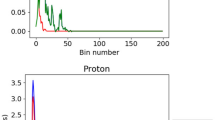Abstract
Machine learning algorithms have shown their usefulness in a countless variety of fields. Specifically in the astrophysics field, these algorithms have helped the acceleration of our understanding of the Universe and the interaction between particles in recent years. Deep learning algorithms, enclosed in machine learning field, are showing outstanding performance in problems where spatial information is crucial, such as images or data with time dependency. Cosmic rays are high-energy radiation, mainly originated outside the Solar System and even from distant galaxies that constitute a fascinating problem in Physics today. When a Ultra-High Energy Cosmic Ray enters the Earth’s atmosphere an extensive air shower is generated. An air shower is a cascade of particles and can be recorded with surface detectors. This work develops a supervised learning algorithm to classify the signals recorded by surface detectors with the aim of identifying the primary particle giving rise to the extensive air shower. Convolutional Neural Networks along with Feed Forward Neural Networks will be compared. Also, the aggregation of information from different surface detectors recording the same phenomenon will be studied against using the information of a single surface detector.
Access this chapter
Tax calculation will be finalised at checkout
Purchases are for personal use only
Similar content being viewed by others
References
The Pierre Auger Collaboration: The pierre auger cosmic ray observatory. Nucl. Instrum. Methods Phys. Res., Sect. A 798, 172–213 (2015)
Argiro, S., et al.: The offline software framework of the pierre auger observatory. Nucl. Instrum. Methods Phys. Res., Sect. A 580(3), 1485–1496 (2007)
Aznan, N.K.N., Bonner, S., Connolly, J., Al Moubayed, N., Breckon, T.: On the classification of ssvep-based dry-eeg signals via convolutional neural networks. In: 2018 IEEE International Conference on Systems, Man, and Cybernetics (SMC), pp. 3726–3731. IEEE (2018)
Choma, N., et al.: Graph neural networks for icecube signal classification. In: 2018 17th IEEE International Conference on Machine Learning and Applications (ICMLA), pp. 386–391. IEEE (2018)
Erdmann, M., Glombitza, J., Walz, D.: A deep learning-based reconstruction of cosmic ray-induced air showers. Astropart. Phys. 97, 46–53 (2018)
Goodfellow, I., Bengio, Y., Courville, A.: Deep Learning. MIT Press (2016). http://www.deeplearningbook.org
Guillén, A., et al.: Deep learning techniques applied to the physics of extensive air showers. Astropart. Phys. (2019). https://doi.org/10.1016/j.astropartphys.2019.03.001, http://www.sciencedirect.com/science/article/pii/S0927650518302871
Huennefeld, M.: Deep learning in physics exemplified by the reconstruction of muon-neutrino events in icecube. PoS, p. 1057 (2017)
Kingma, D.P., Ba, J.: Adam: a method for stochastic optimization. CoRR abs/1412.6980 (2014). http://arxiv.org/abs/1412.6980
Krizhevsky, A., Sutskever, I., Hinton, G.E.: Imagenet classification with deep convolutional neural networks. In: Advances in Neural Information Processing Systems, pp. 1097–1105 (2012)
LeCun, Y., Bengio, Y., Hinton, G.: Deep learning. Nature 521(7553), 436 (2015)
LeCun, Y., et al.: Backpropagation applied to handwritten zip code recognition. Neural Comput. 1(4), 541–551 (1989)
Ostapchenko, S.: Monte carlo treatment of hadronic interactions in enhanced pomeron scheme: QGSJET-II model. Phys. Rev. D 83(1), 014018 (2011)
Paszke, A., et al.: Automatic differentiation in pytorch (2017)
Pedregosa, F., et al.: Scikit-learn: machine learning in python. J. Mach. Learn. Res. 12, 2825–2830 (2011)
Acknowledgements
This research has been possible thanks to the support of projects: FPA2015-70420-C2-2-R, FPA2017-85197-P and TIN2015-71873-R (Spanish Ministry of Economy and Competitiveness –MINECO– and the European Regional Development Fund. –ERDF). We thank the Pierre Auger Collaboration for letting us use the simulated event samples that are at the core of this study.
Author information
Authors and Affiliations
Corresponding author
Editor information
Editors and Affiliations
Rights and permissions
Copyright information
© 2019 Springer Nature Switzerland AG
About this paper
Cite this paper
Carrillo-Perez, F., Herrera, L.J., Carceller, J.M., Guillén, A. (2019). Improving Classification of Ultra-High Energy Cosmic Rays Using Spacial Locality by Means of a Convolutional DNN. In: Rojas, I., Joya, G., Catala, A. (eds) Advances in Computational Intelligence. IWANN 2019. Lecture Notes in Computer Science(), vol 11506. Springer, Cham. https://doi.org/10.1007/978-3-030-20521-8_19
Download citation
DOI: https://doi.org/10.1007/978-3-030-20521-8_19
Published:
Publisher Name: Springer, Cham
Print ISBN: 978-3-030-20520-1
Online ISBN: 978-3-030-20521-8
eBook Packages: Computer ScienceComputer Science (R0)




